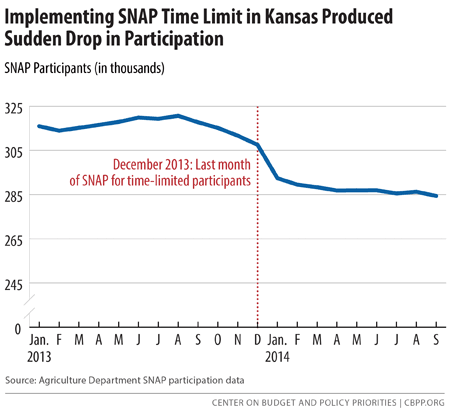BEYOND THE NUMBERS
Roughly 1 million of the nation’s poorest people will be cut off SNAP (formerly food stamps) over the course of 2016 — even if they’re looking for a job but can’t find one —because a three-month time limit on benefits for unemployed childless adults who aren’t disabled will return in many geographic areas.
As our new report explains, the affected people will lose an average of $150 to $200 per person per month. For this group, that’s a dramatic loss. People subject to the three-month limit have average monthly income of about 19 percent of the poverty line (about $2,200 per year for a household of one in 2014), and they typically don’t qualify for other income support.
Part of the 1996 welfare law, the three-month limit hasn’t been in effect in most states in recent years because states can waive it temporarily in areas with high unemployment. But as unemployment rates fall, fewer areas will qualify for waivers, even though many people —including many lower-skilled workers — who want to work still can’t find jobs. People subject to the three-month limit generally have limited education and skills and limited job prospects.
Some states that have already imposed the time limit have seen SNAP caseloads drop sharply — much faster than the slow decline they’d experienced due to an improving economy. (In this economic recovery, like previous ones, SNAP caseloads have fallen as unemployment has improved.) In Kansas, for example, the caseload decline three months after the time limit returned was more than triple the previous trend (see graph).

Unemployed childless adults can continue to receive SNAP beyond three months by participating in a work or training program for at least 20 hours a week. But very few states provide these programs to all who need them. As a result, someone who wants to work but can’t find a job, and is willing to participate in job training but has no opportunity to do so, will lose his or her SNAP benefits after three months.
Congress still has time to mitigate the harm. It could, for example, require a state to offer a job or training position or other work activity — or require job search — for all adults subject to the limit and continue benefits for all who comply. Without any such action, food banks, pantries, and soup kitchens can expect a sustained increase in food requests from this large and widespread loss of assistance.
What’s more, community groups and service providers such as homeless shelters, low-income veterans’ groups, job training centers, and health clinics count on SNAP as a resource for their clients. Those losing SNAP may be forced to choose between food and other necessities, like rent or medicine.
It’s not too early for states, community partners, and nonprofits to start preparing for the return of the three-month limit, which will have a big impact on the people they serve.
